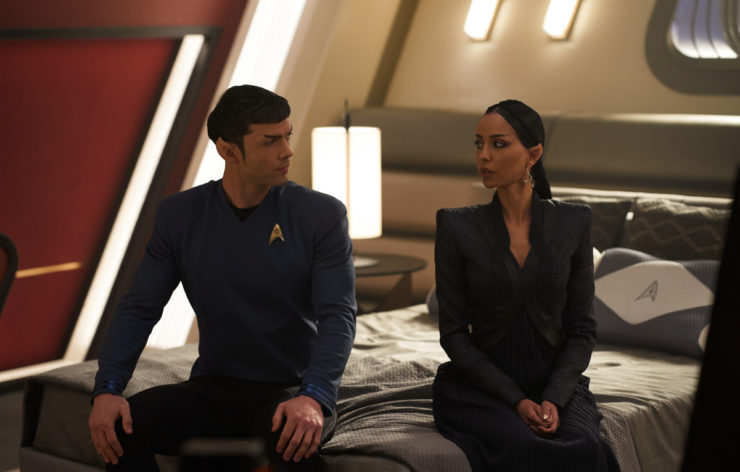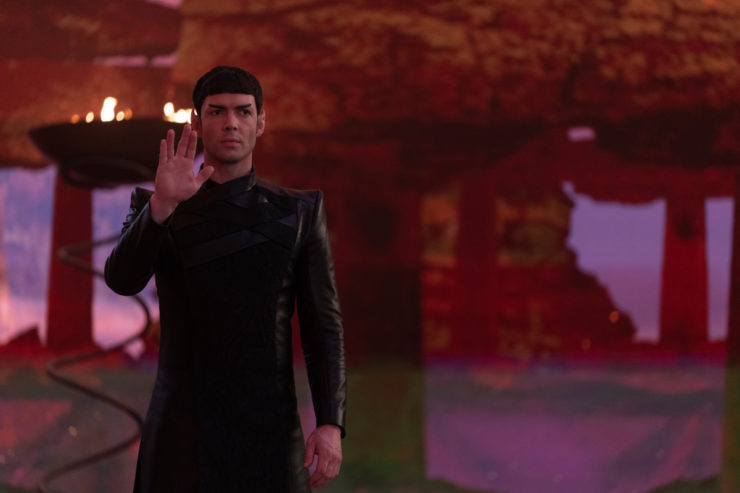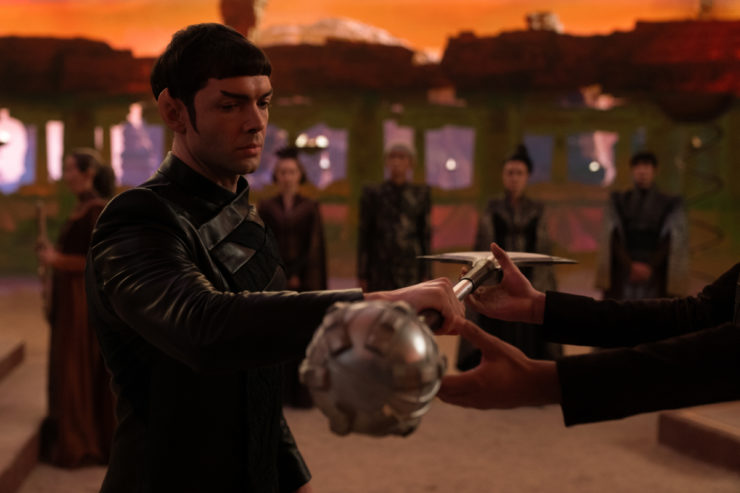I’ve always been drawn to aftermath stories. I’m much more interested in how you recover from the big crisis than in the big crisis itself. It’s probably why “Family”—the followup to “The Best of Both Worlds”—is one of my favorite TNG episodes, why “Home” is an Enterprise episode I’m particularly fond of, and why two of my favorite works of Trek fiction that I’ve written are Breakdowns (one of the stories in the Starfleet Corps of Engineers series written in the aftermath of David Mack’s Wildfire, in which half the crew was killed) and A Singular Destiny (which showed the galactic consequences of the Borg invasion chronicled in Mack’s Destiny trilogy).
So for that, and many other reasons, I enjoyed the hell out of “Spock Amok,” which sees the crew taking downtime while the Enterprise is repaired following the battle against the Gorn last week.
Let’s get the elephant in the room out of the way, which is Yet Another Potential Discontinuity. First, let’s be clear: despite what some fulminating fangoobers online might say, there’s only one true discontinuity here, and it involves the character of Christine Chapel and her response to seeing T’Pring on the viewscreen in the original series’ “Amok Time,” which is the same shock and surprise that everyone else on the bridge of the Enterprise had when Spock identified the woman on the viewer as his wife.
And yet, in “Spock Amok,” taking place ten years earlier, Chapel knows all about T’Pring, indeed gives Spock advice on how to repair his relationship with her. This discontinuity is of a piece with Jess Bush’s far more free-wheeling portrayal of Chapel than Majel Barrett gave us five decades ago. The Chapel of the original series was a borderline pathetic figure, longing constantly for Spock. (McCoy even takes a somewhat-mean-spirited dig at her in “Amok Time” on the subject when she’s trying to bring him plomeek soup.)
Some might see another discontinuity involving Chapel, but I’m not convinced that it is one yet. She gets together with someone who’s obviously a fuck-buddy, but drops him when he asks her for a more serious relationship. The notion of a single Chapel who is footloose and fancy-free would seem to contradict what was established in the original series’ “What Are Little Girls Made Of?” that Chapel was searching for her long-missing fiancé Dr. Roger Korby. But toward the end of the episode, she’s talking to Ortegas about it, and saying how she doesn’t want a relationship to get serious. She starts to say something, stops, says it’s nothing, and that’s the end of it. I really think that Chapel is sticking with meaningless hookups rather than a real relationship precisely because she’s holding out hope that Korby is still out there. Or maybe she at this point thinks that Korby’s dead and won’t get any notion that he’s still alive until later. Remember, this show takes place ten years prior to the original series, and a lot can happen in a decade…

Again, Chapel’s response to T’Pring in the 1967 episode is the only true discontinuity here. There’s nothing in “Amok Time” (which I rewatched before writing this review just to be sure) that precludes Spock and T’Pring making an attempt at a relationship ten years prior to the episode in question. Again, a lot can happen in ten years, and it’ll be fascinating to watch how it develops. Especially since I fully expected this episode to sow the seeds of T’Pring’s dissatisfaction with being affianced to Spock, but it’s apparently going to be more complicated than that—T’Pring actually comes to a better understanding of Spock, and he of her.
That’s accomplished through one of the hoariest science-fiction clichés in the book: the body-swap episode!
And yes, I groaned when I realized that Spock and T’Pring’s attempt at an intense mind-meld to better understand each other resulted in their katras switching bodies. But I also enjoyed the thing that body-swap episodes are really there for: to give the actors a chance to play. Ethan Peck and Gia Sandhu both did wonderful jobs of impersonating each other, from the body language to the conversational style. It was beautifully done. Peck and Sandhu already established their letter-perfect chemistry in “Strange New Worlds,” and it continues magnificently here.
Getting there is a challenge for both T’Pring and Spock. The episode opens with a dream sequence where Spock finds himself in the wedding arena that we first saw in “Amok Time,” preparing to wed T’Pring, but what seems like a rehash of “Amok Time” instead turns into a rehash of Superman III, as Spock suddenly becomes human, and T’Pring invokes kal-if-fee. She chooses the Vulcan Spock as her champion, and so human Spock fights Vulcan Spock with lirpas. First of all, they do an amazing job re-creating the set from 1967, and then, bless her pointy little head, Nami Melumad also re-created the iconic fight music from the episode for the score, and it is glorious. (Da-da da da da da da da-da DA DA!)
Spock is concerned that T’Pring will find him too human, plus there’s her already-stated concern that he will put Starfleet ahead of their relationship, which she expressed displeasure with in “Strange New Worlds.”
Because this is a comedy episode, both Spock and T’Pring have to do the other one’s job. And yes, for the first time in five decades, we find out what T’Pring actually does, since she was created in 1967 when women’s only function was to be a wife. In her case, she is the person they send to find Vulcans who have been deemed V’tosh ka’tur, Vulcans who have strayed from logic, and convince them to come back to the fold, as it were. (This is the first time the term V’tosh ka’tur has been used onscreen since the concept was introduced in Enterprise’s “Fusion.”)
T’Pring’s assistant had been tasked with tracking down their current V’tosh ka’tur, but he says that he will only talk to T’Pring. Spock-in-T’Pring’s-body tries his best to do her job, but it doesn’t really work out, and he winds up slugging him. Mind you, he’s totally obnoxious, Vulcan snottiness matched with human emotion, and you can’t really blame Spock for socking him in the jaw. In fact, T’Pring doesn’t blame him when he tells her later…

As for T’Pring, she has to pretend to be Spock in a negotiation with an alien species that occupies space that is proximate to the Federation, the Klingons, and the Romulans. An alliance with them would make the Federation’s life much easier, while them allying with the Klingons or Romulans would be disastrous for the Federation.
What’s interesting about these aliens is that their negotiating strategies seem to keep changing. It’s Pike who finally figures it out in the end. When they first talked to a Tellarite diplomat, they argued. When they first talked to Pike, they were pleasant and friendly. When they talked to Spock (and later to T’Pring-in-Spock’s-body) they were coldly rational and logical. Pike theorizes that they take the other person’s viewpoint, and what they want is someone who will take theirs—so he comes to them and looks at the alliance possibilities from their POV, including a frank declaration that it may not be the best thing for them.
April is aghast and thinks Pike may have scotched the alliance, but it does work, and the Federation has a new ally. In a lovely touch, they signal their new alliance by deploying a solar-sail ship flying the flag of their new ally. The sight of a big-ass sailing ship flying the Federation flag is simply magnificent.
Those are only two of the storylines going on, as the whole crew is on leave. Well, except for Number One and La’An, who stay on board and do more work, because that’s how they have their fun.
Buy the Book


The City Inside
Number One gets some less-than-salubrious revelations here. The first is that the crew refers to her as where fun goes to die, a nickname that M’Benga accidentally lets slip in the transporter room. Una gets cranky about that, and worries that being first officer means she’s too distant from the crew. La’An reassures her that it’s not because she’s first officer, it’s because she terrifies everyone—which La’An, of course, thinks is totally cool.
The pair of them try to see if they can remember what it’s like to be a junior officer thanks to two ensigns who are playing “Enterprise Bingo.” Mentioned by Ortegas in “Children of the Comet,” we see a couple of ensigns—the communications officer and a Bolian—taking an unauthorized EVA walk.
Now the scene where they’re interrogated had me laughing my ass off, because it so beautifully showed the differences between Una and La’An. Number One is friendly with the Bolian, while La’An does everything she can to intimidate the communications officer. Both tactics work, mind you, but I think Number One’s is better for morale. (And while it’s played for laughs, that La’An would resort to such scare tactics with a crewmate is rather disturbing…)
Having confiscated a list of Enterprise Bingo, they decide to try some of it, and while they do enjoy parts of it, it doesn’t entirely make them feel like they know the lower-decks crew better.
But it does provide a lovely moment at the very end, as the last item on the list is to sign the scorch. The oldest part of the Enterprise hull is a piece that has a scorch mark on it, and it’s been kept as part of the hull for sentimental reasons. Several crewmembers have already signed it, and La’An and Una add their names. (The story of how that scorch got there, presumably while April was in command, is one I’d like to see told some day…) And while they’re standing on the saucer doing that, the solar-sailing ship does its flyby…
I like how this episode defied several of my expectations, particularly that T’Pring would come out of it on the road to becoming the T’Pring we saw played by Arlene Martel, but it’s going to be more complicated than that, which I approve of. I also approve of making T’Pring a more well-rounded character. Most appearances by the character in tie-in fiction has her as at best an unpleasant person and at worst an out-and-out villain. I like this more nuanced portrayal more, and I’m curious to see how it’s going to get to where she is in “Amok Time.” Of course, Spock isn’t really Spock yet—the person Kirk called the best first officer in the fleet is a lowly lieutenant at this point, and not the legend that T’Pring was concerned about marrying in “Amok Time.”

Peck also beautifully sells Spock’s admission to T’Pring of why he has devoted himself to Starfleet: as established in the original series episode “Journey to Babel,” the animated episode “Yesteryear,” and the 2009 movie, Spock was tormented as a child for being a halfbreed. In Starfleet, he’s not half-human or half-Vulcan, he’s just Spock.
What I thought would just be a light episode that showed the crew having fun turned out to be a much more moving one. We get some welcome depth to an old character (T’Pring), a lovely portrayal of an even older one (Spock), and the captain getting to be awesome once again (and doing so while wearing the alternate green tunic that Kirk also wore in “The Enemy Within” and in several second-season episodes, which was fun to see).
Finally, as a public service, here is the entirety of Enterprise Bingo. The rules are that you must complete ten of the eleven tasks, and you can’t get caught.
- Use transporter to re-flavor gum. (Which apparently works. Go fig’.)
- Phaser stun club.
- Turbolift two-floor shout challenge. (This was my absolute favorite thing on the list, and watching Number One consistently beat La’An at it was hilarious.)
- Set the Universal Translator to Andorian.
- Gravity boot hang challenge. (I’m real curious about this one, especially since it’s boot, singular.)
- Medical tricorder challenge: Vulcan marupal. (This might be a typo for “marsupial.”)
- Food replicator challenge: durian fruit.
- Sneak a tribble into the transporter buffer.
- Sit in the captain’s chair.
- EV suit challenge: unsanctioned space walk. (This is the one the two ensigns were caught doing by Number One and La’An. They were so close!)
- Sign the scorch.
Keith R.A. DeCandido urges everyone to support the Kickstarter for Phenomenons: Season of Darkness, the second volume in the shared-world superhero anthology series published by Crazy 8 Press. The anthology features stories by Keith and fellow Trek prose stylists Michael Jan Friedman (who also created and is the editor of the series), Peter David, Geoffrey Thorne, Ilsa J. Bick, Robert Greenberger, Paul Kupperberg, Aaron Rosenberg, and Glenn Hauman, as well as screenwriter Dan Hernandez and novelists Mary Fan, Michael A. Burstein, Marie Vibbert, Russ Colchamiro, Hildy Silverman, and Alex Segura. Please consider supporting the anthology on Kickstarter!










